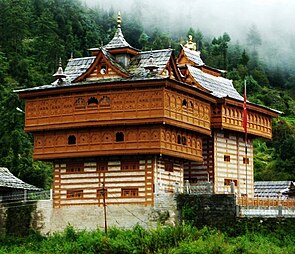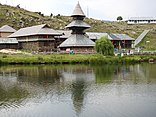
Kath-Kuni is an indigenous construction technique prevalent in the isolated hills of northern India, especially in the region of Himachal Pradesh Kath is derived from the Sanskrit word kāshth meaning wood and kuni from the word kona meaning corner. It also goes by other names such as kath-kona, kath-ki-kanni in Sarahan region
It is a traditional technique that uses alternating layers of wood and stone masonry, held in place without using mortar. It has been transmitted orally and empirically from one generation to the next, through apprenticeships spanning a number of years.[1]
The relative isolation of the hills, and demanding weather have fostered development and persistence of this distinctive vernacular cator and cribbage architecture style.[2] This is most evident in the temples in the region.

- ^ Khimta, Abha Chauhan (2018-08-29). "Political Participation of Women in Himachal Pradesh in India: Impact on Social Change". International Conference on Future of Women. The International Institute of Knowledge Management-TIIKM: 11–21. doi:10.17501/icfow.2018.1102.
{{cite journal}}: Cite journal requires|journal=(help) - ^ "The Himalayan Vernacular: Kath-Khuni Architecture". Sahapedia. Retrieved 2022-12-15.
© MMXXIII Rich X Search. We shall prevail. All rights reserved. Rich X Search
